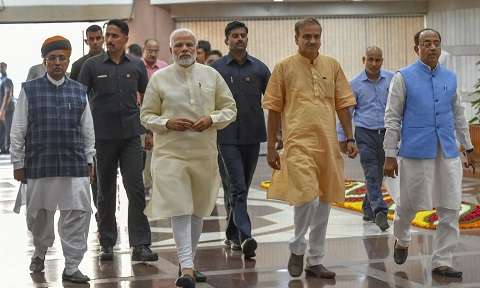
no confidence motion does not pose a danger to the government because it has the support of at least 332 Lok Sabha members.
The opposition Indian National Developmental Inclusive Alliance (INDIA) submitted a resolution of no confidence motion against Prime Minister Narendra Modi’s administration on Wednesday, and Speaker of the Lok Sabha Om Birla accepted the notice.
Assam-born Congressman Gaurav Gogoi presented the notice earlier at 9:20am as part of the INDIA grouping’s effort to compel Modi to respond to concerns like the violence in Manipur.
Birla stated that he will discuss the situation with all parties and within the bounds of the law. “I’ll let you know when the discussion’s schedule is available.”
Any no-confidence motion notice lodged before 10am must be heard the same day, per the rules.
People with knowledge of the situation said it was doubtful that the motion will be discussed in Lok Sabha on Wednesday.
Due to disagreements, interruptions, and the BJP’s refusal of the opposition’s demand that Modi address the Manipur issue, the notice was brought forward.
Union Home Minister Amit Shah proposed a conversation about the state of affairs in the northeastern state in a letter to the leaders of the Opposition on Tuesday in an effort to break the deadlock in both houses of Parliament.
On Tuesday, INDIA’s top officials discussed a motion of no confidence motion. Derek O’Brien, the leader of the Trinamool Congress’ Rajya Sabha floor, later tweeted: “The overarching Parliamentary plan is in place for the INDIA parties. Every day, the tactics used to carry out that approach change. The Lok Sabha’s Rule 198 outlines the steps for introducing a motion of no confidence. “Wait and see, picture abhi baki hai!”

The no confidence motion poses no threat to the government because it has the support of at least 332 Lok Sabha members.
Wednesday morning, the Congress issued a three-line whip requesting the presence of its members. According to Lok Sabha norms, the proposal must have the support of at least 50 lawmakers.
The initial motion of no confidence motion in the Modi administration was unsuccessful on July 20, 2018. That motion was made by MP Srinivas Kesineni of the Telugu Desam Party. During the discussion of that motion, Congressman Rahul Gandhi walked over to the Treasury benches and gave Modi a bear hug.
When the Speaker calls for a motion, a member shall move the motion with the permission of the House pursuant to Lok Sabha Rule 198 (1). To be taken into consideration that day, a member who wants leave must submit notification to the Lok Sabha secretary general by 10am.
The Speaker of the House is required to “ask those members who are in favour of leave being granted to rise in their places, and if not fewer than fifty members rise accordingly, the Speaker shall declare that leave is granted,” as per the regulation.
The Speaker permits “a day or days or part of a day for the discussion of the motion” after the notice is approved.
Due to their demand that Modi speak about the violence in Manipur, the Opposition shut down parliamentary business for three days during the monsoon session.
In 2003, a no-confidence resolution was put forth by Sonia Gandhi, who was the head of the Congress at the time, against the Atal Bihari Vajpayee administration. After a discussion that started with Gandhi’s “charge sheet” against the government, the motion was defeated. Vajpayee lost the general election the next year.
According to opposition leaders, talks between leaders of the Congress and Trinamool Congress to introduce a resolution of no confidence began on Monday morning. At the Opposition’s floor strategy meeting on Tuesday, Rahul Gandhi, who was earlier this year disqualified from the Lok Sabha, was consulted before the decision was made.
What is no confidence motion
A vote of no confidence, also known as a motion of no confidence, no confidence motion, motion of confidence, or vote of confidence, is a declaration or vote regarding whether a person in a position of responsibility, such as in management or government, is still deemed fit to hold that position.
This could be due to factors like their shortcomings in one area, their failure to fulfil their duties, or the decisions they make being deemed unfavourable by other members.
The legislative motion shows the head of state that the elected legislature either still has confidence in one or more members of the appointed administration or no longer does. In certain nations, a minister must resign if a no confidence motion is carried against him or her. Typically, if the minister in question is the premier, all other ministries are required to resign as well.
A move for censure differs from a no confidence motion. A vote of “no confidence” may result in the removal of the council of ministers or other officeholders and frequently in the dissolution of the majority of the executive branch’s leadership, depending on the rules of the organisation in question. On the other hand, “censure” expresses dissatisfaction but does not cause ministers to resign.
A single minister or a number of ministers could be the targets of the motion of censure. However, a no-confidence motion can be more focused on the entire government depending on the constitution of the nation. Again, depending on the regulations that apply, moves for censure may need to include specific justifications, whereas motions for no-confidence may not.





















































































































































































































































































































































































































































































































































































































































































































































































